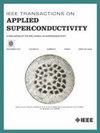Design and Analysis of Parallel Hybrid-Excited Superconducting Electromagnetic Support System for High-Speed Electromagnetic Suspension Maglev
IF 1.7
3区 物理与天体物理
Q3 ENGINEERING, ELECTRICAL & ELECTRONIC
引用次数: 0
Abstract
The conventional electromagnetic maglev train is currently the sole commercially operated high-speed maglev train; however, it faces challenges, such as a narrow suspension gap, excessive energy consumption, and heat dissipation issues. High-temperature superconducting materials possess the advantages of zero resistance and high current-carrying capacity. Building upon the conventional high-speed electromagnetic levitation train, this article proposes a parallel hybrid-excited superconducting electromagnetic support system that incorporates both high-temperature superconducting and conventional components. By considering the symmetry of the support arm and electromagnetic field, certain normally conducting electromagnets are replaced with superconducting ones. Utilizing the conventional electromagnetic support system as a basis, we conducted finite-element simulation to establish and analyze the superconducting hybrid electromagnetic support and linear motor traction system. At suspension gaps of 15 and 20 mm, superconducting electromagnets contribute 80% of the suspension force without significant traction loss, while normally conducting electromagnets require smaller currents for system support and traction functions. The suspension gap can be effectively controlled within a certain safe range (15–20 mm) by maintaining a constant current in the electromagnetic coil.高速电磁悬浮磁悬浮并行混合激励超导电磁支撑系统的设计与分析
传统电磁磁悬浮列车是目前唯一商业化运行的高速磁悬浮列车;但也面临悬架间隙过窄、能耗过大、散热等问题。高温超导材料具有零电阻和高载流能力的优点。本文在传统高速电磁悬浮列车的基础上,提出了一种高温超导与常规元件相结合的并联混合激励超导电磁支撑系统。考虑到支撑臂与电磁场的对称性,用超导电磁铁代替了正常导电的电磁铁。以传统电磁支撑系统为基础,进行有限元仿真,建立并分析了超导混合电磁支撑与直线电机牵引系统。在悬吊间隙为15和20 mm时,超导电磁铁贡献了80%的悬吊力,而没有明显的牵引力损失,而通常导电的电磁铁需要更小的电流来支持系统和牵引功能。通过保持电磁线圈中的恒流,可以有效地将悬浮间隙控制在一定的安全范围内(15 - 20mm)。
本文章由计算机程序翻译,如有差异,请以英文原文为准。
求助全文
约1分钟内获得全文
求助全文
来源期刊

IEEE Transactions on Applied Superconductivity
工程技术-工程:电子与电气
CiteScore
3.50
自引率
33.30%
发文量
650
审稿时长
2.3 months
期刊介绍:
IEEE Transactions on Applied Superconductivity (TAS) contains articles on the applications of superconductivity and other relevant technology. Electronic applications include analog and digital circuits employing thin films and active devices such as Josephson junctions. Large scale applications include magnets for power applications such as motors and generators, for magnetic resonance, for accelerators, and cable applications such as power transmission.
 求助内容:
求助内容: 应助结果提醒方式:
应助结果提醒方式:


